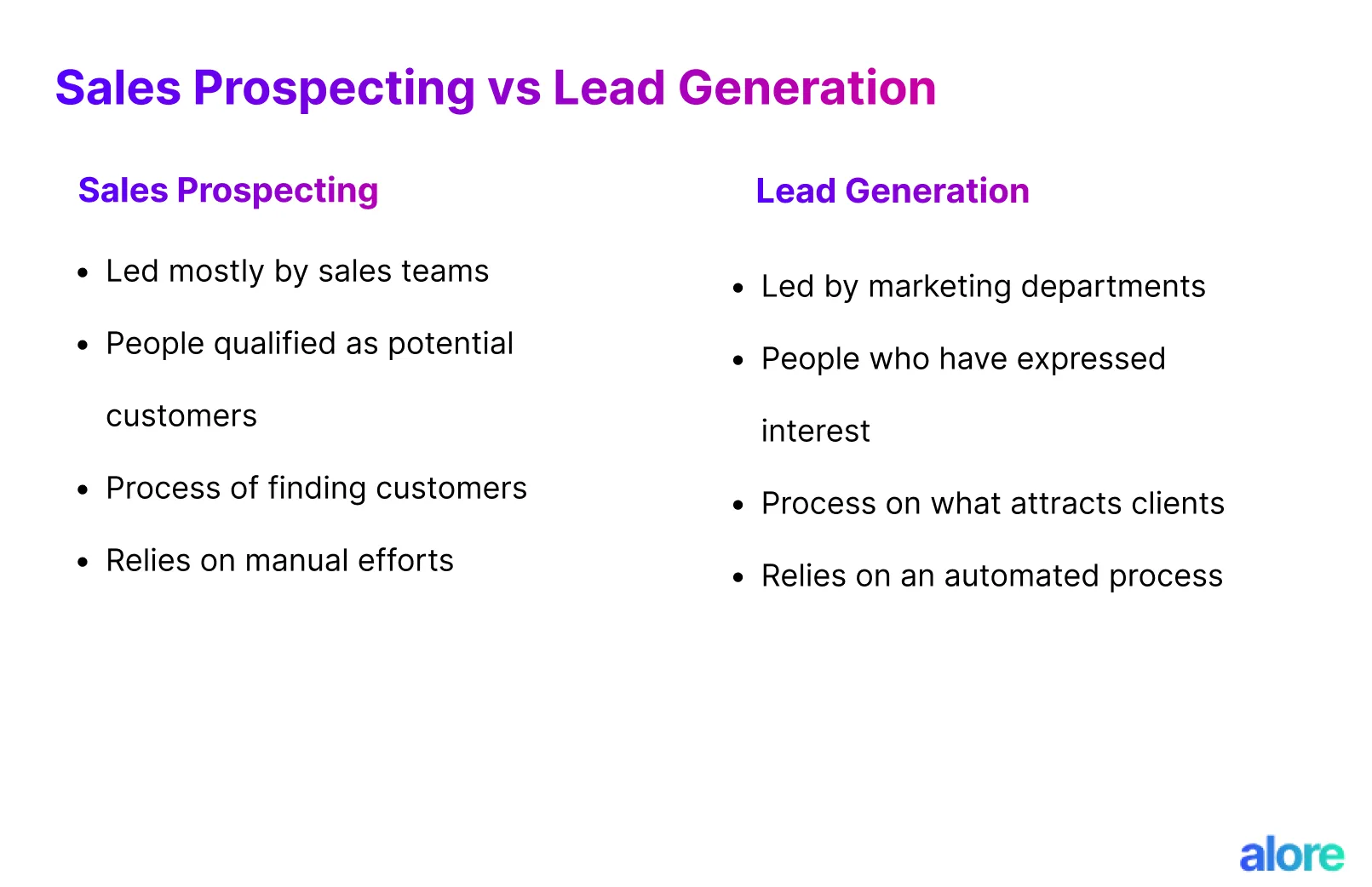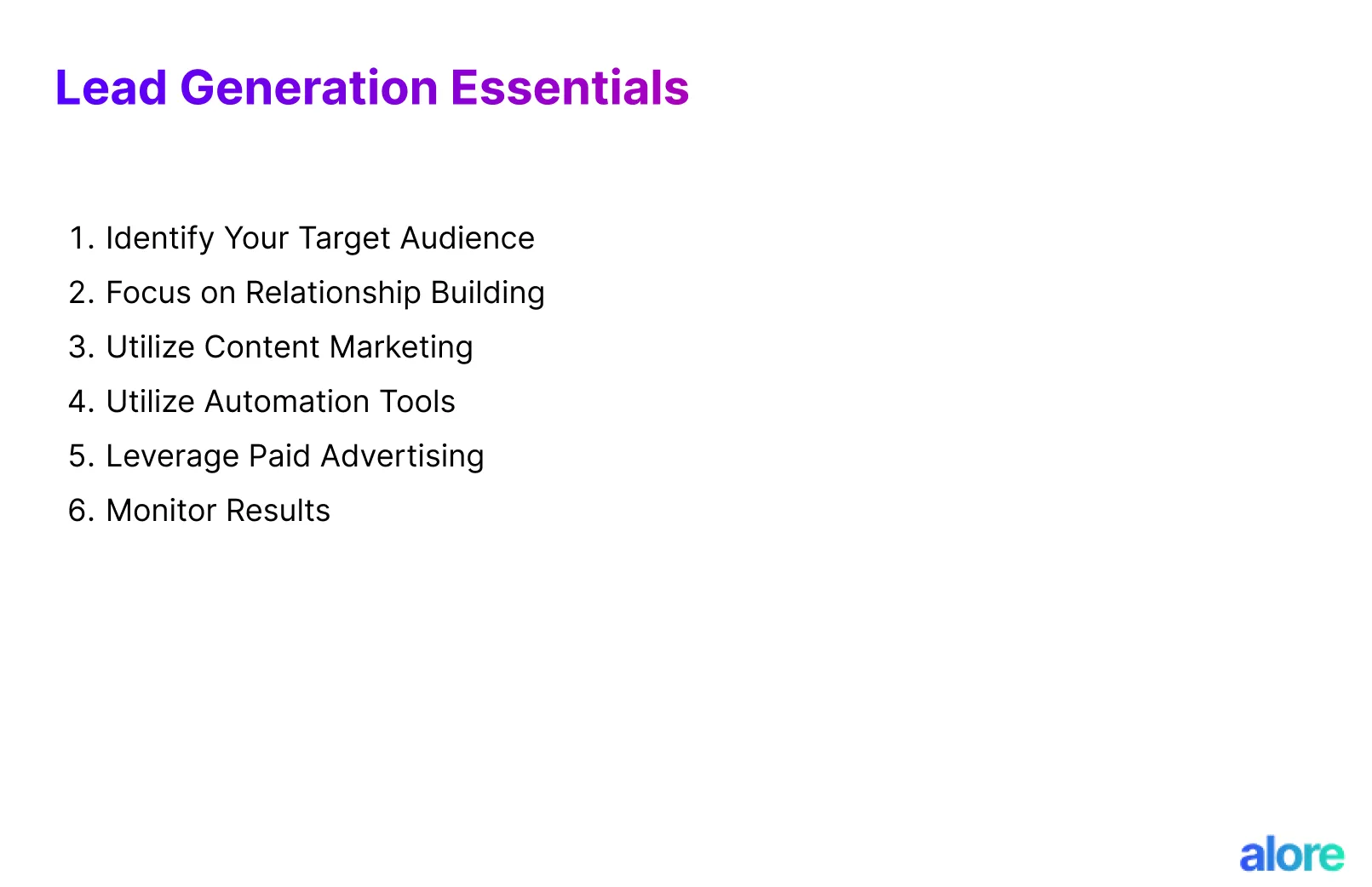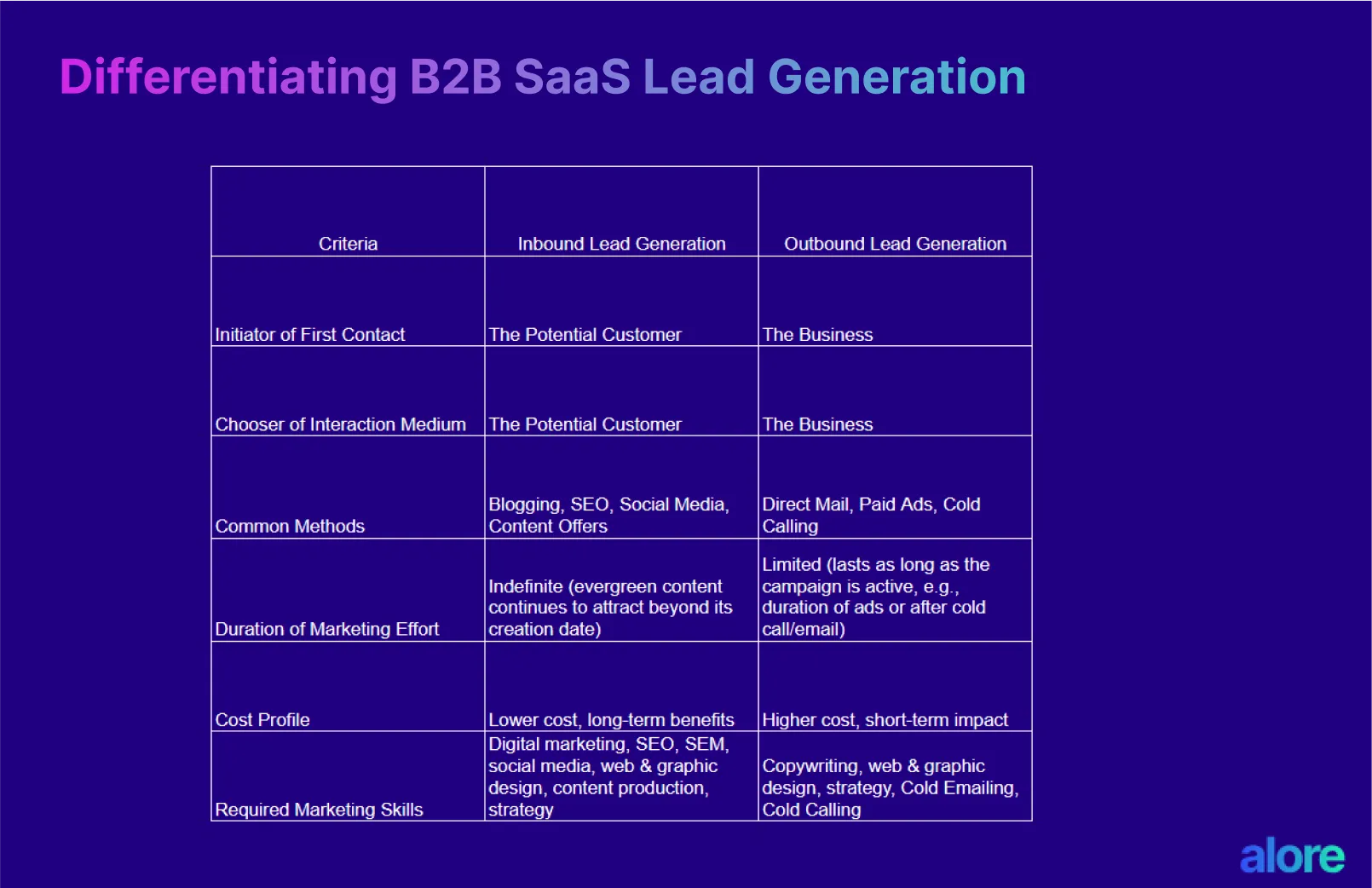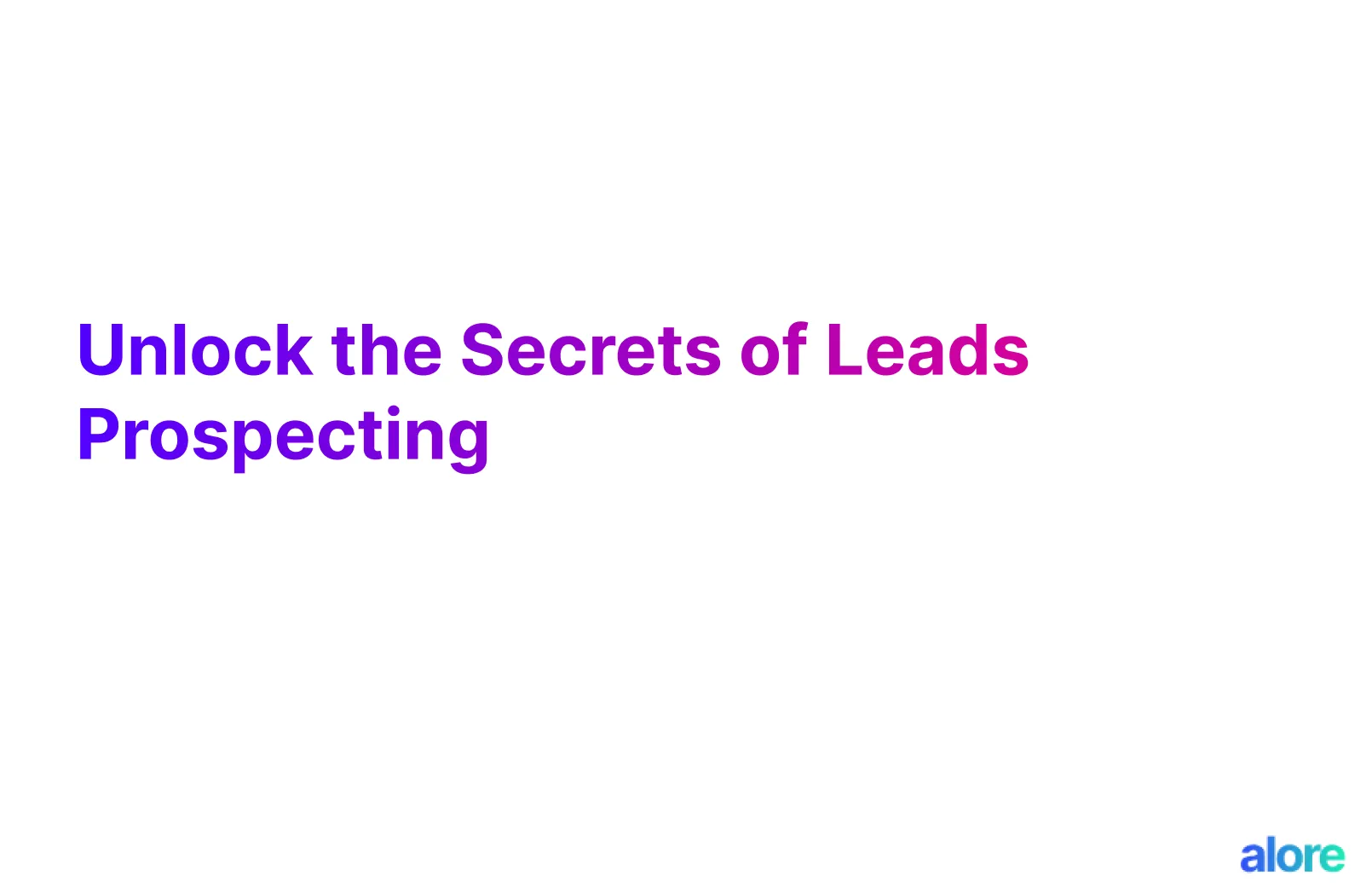Introduction
The Importance of Sales and Lead Generation Efforts in Business
In today's competitive landscape, understanding prospecting, lead generation, and sales is not just beneficial—it's essential.
These strategies for sales rep serves as the backbone of your sales process and are critical for the growth and sustainability of your business.
Why focus on prospecting?
This proactive approach involves identifying and reaching out to potential customers, also known as leads, to initiate the sales process.
Conversely, lead generation is a broader strategy encompassing various marketing efforts, including online advertising and content marketing campaigns, to attract potential customers to your sales funnel.
Data shows businesses with cohesive sales and marketing teams are 67% more effective at generating leads and closing deals. This statistic underscores the importance of aligning your sales process with lead generation efforts.
Sales Prospecting vs Lead Generation

What Makes Sales Prospecting Different from Lead Generation?
Sales prospecting and lead generation serve distinct roles in a business's growth strategy. Sales prospecting is an active, targeted approach. According to industry data, 40% of salespeople say prospecting is the most challenging part of the sales process. It involves a sales team or reps actively identifying and reaching out to potential customers through methods like cold calling, which has a success rate of 1-3%.
In contrast, the lead generation process is often managed by marketing teams and has a broader scope. A HubSpot report indicates that 65% of businesses identify lead generation as their top marketing challenge. This strategy employs a variety of tactics, from content marketing that can increase website traffic by up to 55%, to online advertising, which has an average ROI of 200%.
When Prospecting and Lead Generation Work Together
Combining sales prospecting and lead generation can optimize your sales process. Data shows that companies with aligned sales and marketing teams are 67% more effective at closing deals.
For example, marketing departments can attract potential clients through inbound marketing, which has been shown to lower the cost of lead acquisition by 60%.
Meanwhile, sales teams can use cold outreach to engage those who have shown purchase intent, increasing the likelihood of conversion by up to 20%.
Understanding Sales Qualified Leads and Marketing Qualified Leads
Differentiating between Sales Qualified Leads (SQLs) and Marketing Qualified Leads (MQLs) is vital for efficient lead generation.
- SQLs: These leads are ready for the final stages of the sales funnel. They've shown purchase intent and are primed for closing.
- MQLs: These leads have engaged with marketing materials but haven't shown direct purchase intent.
Understanding these categories can increase your conversion rate by as much as 10%.
Navigating Challenges in Prospecting for leads

Overcoming Sales Prospecting Challenges
According to industry data, 42% of sales reps feel they don't have enough information before calling a potential customer.
This is where the role of a well-equipped CRM system becomes crucial.
Unfortunately, many sales teams are still not equipped with efficient CRM systems, which hampers their performance.
Solutions:
- Equip Sales Teams: The first step is to provide your sales teams with advanced analytics tools. These tools can offer insights into customer behavior, enabling a more targeted approach.
- Utilize Social Selling: Platforms like LinkedIn have emerged as powerful tools for identifying potential customers. Social selling allows you to engage with leads in a more natural, less intrusive manner.
- Follow-Up Strategy: Don't underestimate the power of a follow-up. Studies indicate that 80% of sales require at least five follow-ups after the initial contact. So, persistence is key here.
Tackling the Biggest Lead Generation Challenges
A staggering 61% of marketers report that generating high-quality leads is their biggest challenge. Another hurdle is the target market.
Knowing your audience is half the battle won. Use data analytics to craft accurate buyer personas. This ensures that your marketing materials and campaigns resonate with the right audience.
Choosing the Right Approach for Your Sales Process
Your focus between the two depends on factors like your business model and the skill set of your sales reps.
For instance, B2B companies may rely more on lead generation strategies, while B2C companies might focus more on sales prospecting.
Companies that excel in lead generation are 7 times more likely to exceed their revenue goals. That's not a number to ignore.
Sales Prospecting Strategies

Utilizing Social Platforms for Finding Prospects
A LinkedIn study found that 78% of social sellers outperform peers who don't use social media.
So, how can you tap into this resource effectively?
Scrolling endlessly through LinkedIn won't get you anywhere. Use advanced search features to identify target accounts that align with your ideal customer profile.
Cold outreach on social media often gets ignored.
Engage thoughtfully by commenting on posts and offering value before introducing your sales pitch.
Segmenting Your Sales Prospect Based on Characteristics
Segmentation is not just a marketing gimmick; it's a necessity.
According to HubSpot, segmented campaigns have a 14% higher open rate than non-segmented ones.
A CRM system filled with unsegmented data can be overwhelming. Use your CRM system to segment prospects based on characteristics like industry, purchase intent, or company size.
Tailor your sales strategies to address the unique pain points of each segment.
Nurturing Potential Customers in Your Sales Funnel
The sales funnel isn't just a theoretical concept; it's a practical tool for converting prospects into customers.
A MarketingSherpa study revealed that 79% of marketing leads never convert, often due to poor nurturing.
Ignoring leads once in the funnel can lead to lost opportunities.
Automated systems can sometimes feel impersonal.
Balance automation with personalized check-ins via calls or emails to make potential customers feel valued.
Lead Generation Essentials for Marketing Teams

Best Practices for Generating Qualified Leads
Generating qualified leads is often cited as the most significant challenge for businesses.
So, how do you overcome this hurdle?
Generating enough traffic to convert into leads. Content marketing is your best friend here.
According to DemandMetric, content marketing costs 62% less than traditional marketing and generates about three times as many leads.
But don't just churn out content; focus on quality and relevance to your target market.
Lead magnets like eBooks, webinars, or even free trials can be incredibly effective.
These tools attract marketing qualified leads—people who have moved beyond casual interest and are looking into solutions to their pain points.
Why It Matters: Without a steady influx of qualified leads, your sales teams are left scrambling. This disrupts your sales process and can even affect team morale.
Targeting the Ideal Customer Profile
Knowing your ideal customer profile isn't just a theoretical exercise; it's necessary for efficient lead generation.
You need to know your ideal customer profile to make your marketing campaigns more effective and to generate interest among potential customers.
Navigating the Buyer's Journey
Understanding the buyer's journey is crucial for aligning your marketing strategies with customer needs.
Tailor your content marketing strategies to each stage. How-to guides and educational webinars are effective in the awareness stage, while product comparisons and case studies work well in the decision stage.
Automation: The Role of CRM Systems
Automation isn't just a time-saver; it's a strategic tool that can significantly impact your lead-generation efforts.
Automation allows your teams to do more with less. It streamlines the sales process, ensures no lead is forgotten, and allows your team to focus on what they do best: selling.
Outbound vs Inbound Prospecting

What is Outbound vs Inbound Prospecting, and What's the Difference?
Outbound prospecting is more proactive, often involving cold outreach techniques like cold calling and email campaigns. It's the traditional form of sales prospecting where you initiate contact with potential customers.
In contrast, inbound prospecting is more passive.
It relies on attracting potential leads to come to you, often through inbound marketing strategies like content marketing, SEO, and social media engagement.
Key Differences:
- Initiation: Outbound involves initiating contact, while inbound waits for leads to come.
- Cost: Outbound can be more expensive due to the resources needed for cold outreach.
- Targeting: Inbound often attracts more qualified leads as they're already interested in your product or service.
Cold Outreach Techniques, Including Cold Calling
Cold outreach remains a staple in the realm of leads prospecting. Contrary to popular belief, cold calling isn't dead; it's evolving.
According to InsideSales.com, cold calling is effective 6.3% of the time when executed with precision.
Sending generic messages can lead to low response rates.
Research your target market and tailor your message to address potential customer pain points.
A single call or email is rarely enough. Implement a follow-up strategy to engage potential leads further.
Leveraging LinkedIn and Networking for Lead Prospecting
LinkedIn has transformed from a mere job-hunting site to a robust platform for sales prospecting and lead generation. With a user base exceeding 700 million, the potential for finding qualified leads is immense.
Standing out can be difficult. Engage in social selling by sharing valuable content and insights.
Simply being active doesn't guarantee lead generation. Develop a go-to-market strategy that includes personalized outreach and consistent engagement.
Inbound Marketing for Inbound Leads
Inbound marketing strategies like content marketing and SEO are designed to pull potential customers toward your business.
HubSpot data reveals that companies actively blogging generate 67% more leads than those who don't.
Content Saturation: The internet is flooded with content. Focus on creating high-quality, targeted content that addresses the pain points of your target audience.
Conversion Issues: Attracting traffic is one thing; converting it is another. Optimize landing pages to capture leads. Tools like Unbounce can be invaluable here.
CRM Systems: Salesforce and HubSpot are industry leaders in CRM, helping businesses manage their sales funnel and automate various aspects of the sales process.
Content Marketing Platforms: WordPress and Medium are excellent platforms for executing your content marketing strategies attracting inbound leads through high-quality articles and posts.
Mastering the Art of Prospecting
Researching and Identifying Potential Customers
You can't approach everyone; you must zero in on your target market. Utilize CRM systems like Salesforce to gather data and identify potential leads.
Prioritizing and Personalizing Your Sales Outreach
Not all leads are the same.
Some are warm leads with high purchase intent, while others still navigate the buyer's journey.
This is where sales reps need to step up their game.
Personalization is crucial. A generic email won't cut it.
For personalized outreach, consider using Alore.io. It allows you to tailor your messages to address the unique needs and pain points of each lead.
Addressing Pain Points and Objections
This is where your sales team shines.
They need to understand the nuances between prospecting and lead generation.
While your marketing teams might focus on inbound marketing, your sales team should be adept at handling objections and offering solutions.
Navigating the Future: Building a Robust Sales Pipeline and Customer Base

As we look ahead, it's clear that the synergy between lead generation and sales will continue to be the linchpin for new business acquisition and growth. But how do you transition from sales prospecting to actually closing deals and retaining customers?
The Sales Pipeline: From Warm Prospects to New Clients
Your sales pipeline is more than just a funnel; it's a roadmap. It guides you from the initial stages of identifying warm prospects to the final stages of acquiring new clients. But remember, a pipeline isn't set in stone. It evolves as your business needs change.
- Existing Customers: Don't overlook the goldmine that is your existing customer base. They can provide referrals and even upsell opportunities.
- New Business: Organic traffic to your company website can be a valuable source of new leads. Use SEO strategies and landing pages to capture these potential clients.
Building Awareness and Expanding Your Customer Base
Awareness is the first step in any sales or marketing strategy. Whether it's through social media or content marketing, building awareness is crucial for attracting your ideal customers.
- Prospecting vs Lead Generation: While prospecting focuses on initiating conversations, lead generation aims to attract potential customers to you. Both are essential components of your overall sales prospecting strategy.
- Business Growth: As you build awareness and generate leads, your business will naturally grow. The key is to maintain a balanced approach that combines both generation and sales prospecting methods.
Leveraging Digital Assets
Your company website is more than just a digital business card. It's a powerful tool for lead generation and customer engagement.
- Landing Page: A well-designed landing page can convert visitors into leads or even customers. Make sure it aligns with your business goals and speaks directly to your target audience.
- Organic Traffic: This is often an underutilized asset. By optimizing your website for search, you can attract a more targeted customer base without the need for paid advertising.
In conclusion, the future of your business hinges on a well-executed sales and marketing strategy. By focusing on sales prospecting and lead generation, you can build a robust sales pipeline that not only brings in new clients but also nurtures existing customers. It's all about creating a sustainable business model that adapts and thrives in a constantly changing marketplace.






.jpg)

.jpg)
